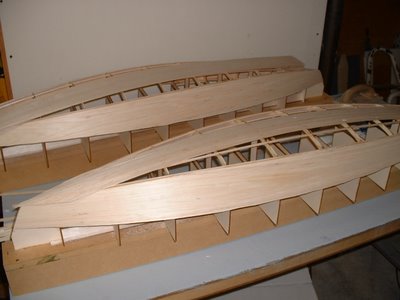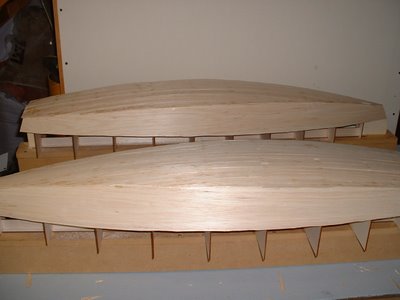After all the fairing required to make the entire hull flow nicely, there were a few more things to take care of prior to the beginning of planking. We had to deal with things that would be inaccessible after the planking was applied. Anything that could be anticipated and easily placed prior to planking removes the need to try and shape things to fit against the inside curve of the hull at a later time.

The appropriately sized diesel engine was chosen, and the appropriately sized engine mounts were built.

The mounts consist of two skid type mounts sitting above the bottom of the bilge.

The picture below shows how the centerboard case sits in relation to the bulkhead that forms the back of the galley sink cabinet.

The entire interior of the aft lazarette needed to be fiberglassed and epoxied, and the final sanding done to smooth it out, ready for paint. Once the planking is applied, this area will only have a small access hole, not something a person wants to have to manipulate fiberglass and sanders through.

Finally the planking could begin....Richard ordered some beautiful 1 x 6 clear vertical grain Western Red Cedar from Specialty Forest Products in Spokane, WA. It is light weight and rot resistant, and thus is desirable for use in wooden boats. The cost of this special lumber was offset by the fact that the waste factor disappeared by ordering it clear and not having to cut around knots, etc as would be the case in a lesser grade or knottier wood.
He ripped it to 1 1/16" width and planed to 3/4" thickness (the dimension from inside to outside of hull). The width of the strips was recommended at 3/4"-1 1/2". It is necessary to keep the strips narrow enough to be able to run each layer of planking the entire length of the boat and have it bend as needed to follow the lines of the hull. The joints are staggered with each layer and epoxy applied to the joint ends.

Epoxy was spread on each long strip and then applied to hull, starting at the sheer.

Massive numbers of clamps were used. Thanks to cheap clamps from Harbor Freight!

Richard decided to start at the sheer, and to work from bottom up exclusively. The theory behind this was that he would never have to be applying epoxy to the underside of any surfaces and working upside down. The hope was that the strips would flow nicely all the way up the hull since it was faired in all directions.

Smear, clamp....


Still not much room to get around the hull, especially with all the clamps in place.

Notice also that the opening into the building room from the garage at the bow has been widened and heightened to help with access and ultimate boat removal. It will soon be drywalled and taped, and hopefully it will be the last bit of renovation needed for boat removal.



A hand sized piece of laminate works great for this scraping.


Read More..

The appropriately sized diesel engine was chosen, and the appropriately sized engine mounts were built.

The mounts consist of two skid type mounts sitting above the bottom of the bilge.

The picture below shows how the centerboard case sits in relation to the bulkhead that forms the back of the galley sink cabinet.

The entire interior of the aft lazarette needed to be fiberglassed and epoxied, and the final sanding done to smooth it out, ready for paint. Once the planking is applied, this area will only have a small access hole, not something a person wants to have to manipulate fiberglass and sanders through.

Finally the planking could begin....Richard ordered some beautiful 1 x 6 clear vertical grain Western Red Cedar from Specialty Forest Products in Spokane, WA. It is light weight and rot resistant, and thus is desirable for use in wooden boats. The cost of this special lumber was offset by the fact that the waste factor disappeared by ordering it clear and not having to cut around knots, etc as would be the case in a lesser grade or knottier wood.
He ripped it to 1 1/16" width and planed to 3/4" thickness (the dimension from inside to outside of hull). The width of the strips was recommended at 3/4"-1 1/2". It is necessary to keep the strips narrow enough to be able to run each layer of planking the entire length of the boat and have it bend as needed to follow the lines of the hull. The joints are staggered with each layer and epoxy applied to the joint ends.

Epoxy was spread on each long strip and then applied to hull, starting at the sheer.

Massive numbers of clamps were used. Thanks to cheap clamps from Harbor Freight!

Richard decided to start at the sheer, and to work from bottom up exclusively. The theory behind this was that he would never have to be applying epoxy to the underside of any surfaces and working upside down. The hope was that the strips would flow nicely all the way up the hull since it was faired in all directions.

Smear, clamp....

Smear, clamp, repeat....

Still not much room to get around the hull, especially with all the clamps in place.

Notice also that the opening into the building room from the garage at the bow has been widened and heightened to help with access and ultimate boat removal. It will soon be drywalled and taped, and hopefully it will be the last bit of renovation needed for boat removal.

It still doesnt look like it will fit from this angle! But tapes dont lie, right?

After laying several rows, Richard waits for the epoxy to begin setting, then scrapes the gross excess to avoid a killer sanding job later.

A hand sized piece of laminate works great for this scraping.

Another fancy addition to the tools was the OMER nail gun that shoots plastic nails from Raptor. The beige plastic nails hold the strips in place while the epoxy dries. The use of any metal nails, other than bronze, would result in the nails rotting and weakening the hull, or needing to be removed. The price of a gun that only shoots plastic nails was cheaper than numerous boxes of expensive silicon bronze ring-shank nails and the shipping costs required to get them here. Not to mention the labor to sink all those nails.

The planking picked up speed as the learning curve was smoothed out.

The planking picked up speed as the learning curve was smoothed out.


















